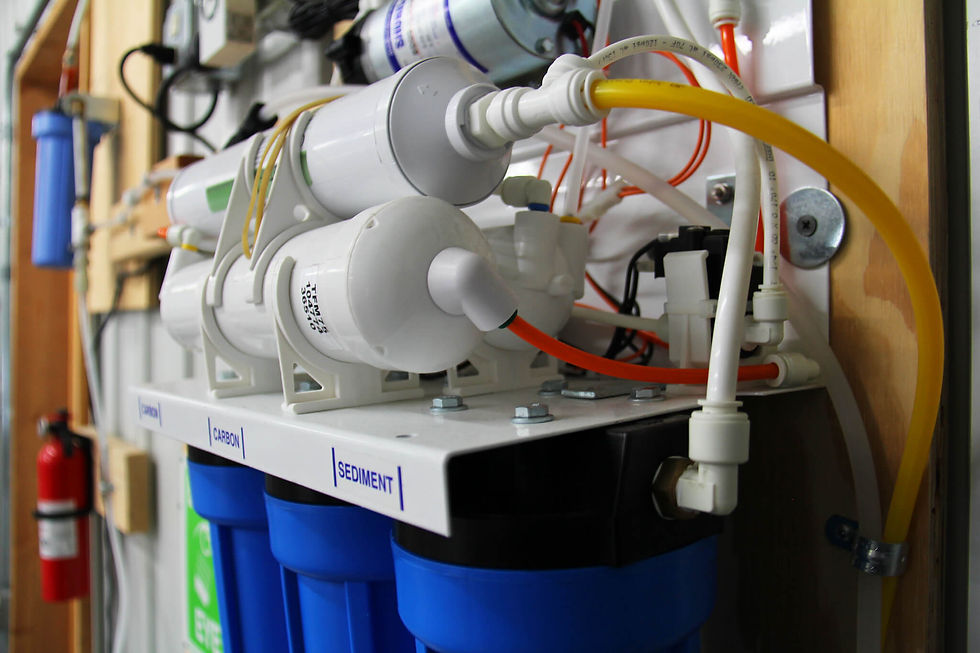Hidden Contaminants Can Linger in Residential Water
- Alina Bradford

- Apr 16, 2024
- 5 min read
But Home Filtration Devices Can Raise Water Purity

Ever poured a glass of tap water and wondered about its purity? While tap water in many areas is considered safe to drink, contaminants can still lurk within it, posing health risks. In fact, according to the Centers for Disease Control and Prevention (CDC), residential tap water can include arsenic, copper, lead, nitrate, and radon, as well as E. coli, Hepatitis A virus, and salmonella. Here’s what one needs to know about tap water and how to make it safer to drink.
What is in US Tap Water?
Tap water can contain a variety of contaminants, including toxic substances, inorganic compounds, bacteria, metals, and microplastics. These can originate from agricultural runoff, industrial discharges, outdated plumbing, and even natural sources. Contaminants in drinking water can cause a variety of health problems, including blood disorders, low IQ, gastrointestinal issues, neurological disorders, and cancer.
Many people get water from public water systems (PWS), which are regulated by the EPA, and include fluoridated community water supplies (CWS). The highest and lowest percentages of people receiving fluoridated water to total population served by CWS are the District of Columbia (100%) and Hawaii (8.5%), respectively, based on 2020 data.

A study by the US Geological Survey reveals that up to 45% of the country's tap water may contain one or more varieties of chemicals called per- and polyfluorinated alkyl substances, commonly referred to as PFAS. Perhaps more disturbing, over 12,000 types of PFAS have been identified, and current testing methods can only detect a fraction of them. Recently, the EPA announced a proposal to lower the maximum contaminant levels (MCLs) of six specific PFAS allowed in drinking water.
A study by the US Geological Survey reveals that up to 45% of the country's tap water may contain one or more varieties of chemicals called per- and polyfluorinated alkyl substances, commonly referred to as PFAS.

A 2023 study took water samples from 38 lakes in 23 different countries on six continents and found that all contained microplastics. This can be concerning since a large portion of drinking water comes from lakes.
How is Tap Water Treated?
Before water flows from the tap, it undergoes several treatment processes to remove impurities and make it safe for consumption. These typically include coagulation and flocculation to clump particles together, sedimentation to allow particles to settle, filtration to remove small particles, and disinfection to kill bacteria and viruses. While effective, these methods have limitations, particularly against some modern contaminants, such as PFAS and micro/nano-plastics.
[Water treatment] typically include[s] coagulation and flocculation to clump particles together, sedimentation to allow particles to settle, filtration to remove small particles, and disinfection to kill bacteria and viruses. While effective, these methods have limitations, particularly against some modern contaminants, such as PFAS and micro/nano-plastics.
Coagulation and Flocculation
The first steps in the water treatment process involve adding chemicals with a positive charge to the water. This causes some contaminants like dirt and iron to combine into larger particles.
The next process is called flocculation. It stirs the water, causing particles to bind together into larger particles, known as flocs.
Coagulation and flocculation processes effectively remove particles and sediments but do not remove dissolved substances or microorganisms.
Sedimentation

Following flocculation, the water moves to sedimentation tanks, where the heavy flocs settle to the bottom due to gravity. Sedimentation is efficient for settling out large particles. However, smaller particles and dissolved substances may not be removed through this process alone.
Filtration
Coagulation and sedimentation can only remove between 27% and 84% of viruses and 32% and 87% of bacteria, so the process continues. After sedimentation, the clear water on top will pass through various filters. These can include sand, gravel, and charcoal filters. The effectiveness of filtration depends on the type of filters used. While it can remove many contaminants, including parasites and some bacteria, some viruses and chemical pollutants may pass through, especially if the filters are not properly maintained.
Disinfection
Before the water is sent through the distribution system to consumer taps, it is disinfected to kill any remaining bacteria, viruses, and parasites. Treatment plants typically use chemical disinfectants like chlorine or chloramine for water disinfection. Most chemical disinfectants are removed from the water before it goes out to the customer. Still, some are left to disinfect the water further as it’s moved through potentially contaminated pipes.
The CDC says drinking water is safe with chlorine levels of up to 4 milligrams per liter (or ppm) and chloramine levels of less than 50 milligrams per liter. However, tap water can contain even tinier amounts—for example, normal chloramine levels in drinking water range from 1.0 to 4.0 milligrams per liter.

Some water treatment plants use UV light and ozone to disinfect drinking water. However, these methods don’t continue disinfecting the water when it passes through contaminated pipes.
Although disinfection effectively kills pathogens, it can leave behind harmful by-products. For example, chlorine can react with organic matter in water to form trihalomethanes (THMs), which are associated with cancer risks.
Furthermore, some pathogens, like Cryptosporidium, are resistant to traditional disinfection methods like chlorination.
Home Water Filtration Options

Water treatment effectively eliminates a large portion of potentially harmful contaminants. However, on occasions, they still get through due to contaminated pipes and other problems. How can one ensure tap water is free from these contaminants? Home water filtration systems can play an important part in making drinking water as safe as possible. Here are some options:
Activated charcoal/carbon adsorption: This method removes organic compounds, chlorine, and chlorine by-products. Filters like pitcher filters and under-sink units commonly use activated carbon. However, they don’t remove hard water minerals or some bacteria unless certified.
Membrane-based filters: These filters, often used in reverse osmosis systems, are typically composed of thin, porous materials that can trap and remove a wide range of impurities, including bacteria and viruses. While highly effective, they require more maintenance than other filters and can be costly. They are also typically used with activated carbon to remove chlorine, fluoride, and other contaminants.
Specialty filters: Some filters target specific contaminants, such as lead or arsenic. Specialty filters can also be used to add minerals back to water after filtration, such as alkaline filters.
Considerations for Choosing a Filter

When selecting a water filtration system, consider the specific contaminants in the water, the system's maintenance requirements, and household water usage. No single filter removes all pollutants, so a combination of systems that provides maximum protection may be considered.
NSF-certified filters are listed in the NSF’s database, which indicates what the filter can clean out of the water and what it can’t.
Also, make sure that the filter is NSF-certified. NSF-certified filters are listed in the NSF’s database, which indicates what the filter can clean out of the water and what it can’t.
Don’t forget to get a filter for each source of one’s home’s drinking water. Here are some options:
Whole-house filtration: This system treats water as it comes into the house. It filters all of the home’s water, not just drinking water. Whole-house systems can be pricey, though.
Under-sink filtration: These attach to the plumbing under the kitchen sink to provide clean water from the tap. DIY installation is possible, but some homeowners may find it difficult.
Faucet-mounted filters: These filters attach to the kitchen faucet and are simple to install. While they are inexpensive compared to whole-house or under-sink filters, they could slow down the water pressure.
Water bottle or pitcher filtration: These are the cheapest and most convenient filtration options. Once filled with water, the built-in filters clean the water. The main problem with bottle or pitcher filtration is that it can be slow and the filters may need frequent replacement.
Refrigerator filters: Don’t forget to make sure the filter on the refrigerator’s in-door water dispenser gets a filter change on a regular basis.
Understanding tap water's treatment processes and the potential contaminants that can remain is key to ensuring that residential water is safe to drink. By choosing the appropriate water filtration system, the risk of consuming harmful contaminants can be significantly reduced.
*Alina Bradford is a safety and security expert that has contributed to CBS, MTV, USA Today, Reader’s Digest, and more. She is currently the editorial lead at SafeWise.com.








This article brings up an important point about the hidden contaminants that can linger in residential water, which many people don't realize. It's a good reminder to always prioritize water quality. For anyone looking to improve the quality of their water, it's essential to rely on trusted sources. Just like how we depend on a good website for information and products, using reputable companies that provide filtration and cleaning solutions can make a huge difference. Brody Chemical, for example, offers excellent products that can help maintain cleanliness in various aspects, from cars to industrial applications, ensuring safety all around.